2. 中国石油大学(北京) 地球科学学院, 北京 102249;
3. 中国科学院地质与地球物理研究所岩石圈演化国家重点实验室, 北京 100029
2. College of Geosciences, China University of Petroleum, Beijing 102249, China;
3. State Kay Laboratory of Lithospheric Evolution, Institute of Geology and Geophysics, Chinese Academy of Sciences, Beijing 100029, China
The thermal history of a basin is usually reconstructed using various paleo-temperature indicators, including vitrinite reflectance (Ro), apatite fission track (AFT), (U-Th)/He in apatite and zircon, reflectance of bitumen and vitrinite-like macerals, the hydrogen index, and fluid inclusions. Ro and AFT are the most widely used indicators and the related modeling methods are relatively well established, other indicators such asillitecry stallinity (IC), Raman spectroscopy, and acoustic rock emissions have also been studied and used in the quantitative reconstruction of paleo-temperatures.In this paper, the thermal history of the western Sichuan depression was reconstructed based on three geothermal indicators: Ro, AFT and the IC index, using the paleo-temperature gradient method, Monte Carlo modeling and the estimation of metamorphic temperature stage respectively, and the maximum paleo-temperatures reconstructed based on different indicators were compared.
The thermal history reconstruction of CY92 using the paleo-temperature gradient method shows that the maximum paleo-temperature gradient of this borehole was ~26 ℃·km-1, the maximum paleo-heat flow was ~60 mW·m-2, both was larger than the present. The thickness of removed sediments on the surface of the unconformity between the Upper Jurassic and the Cenozoic was approximately 1900 m. This indicates that the area has undergone an overall, continuing structural-thermal evolution of cooling, uplifting, and denudation since the rock strata reached the maximum temperatures.AFT thermal history modeling result of CY92-1 reveals that the basin had experienced subsidence between 220 and 140 Ma and a thermal quiet period between 145 and 80 Ma, crustal uplift and erosion occurred in this area between 80 and 40 Ma, but after another thermal quiet period from 40 to ~2.5 Ma, the temperatures of the strata began to rise. The thickness of the removed sediments was estimated to be ~1900 m, which is generally consistent with the Ro analysis results.In borehole CY95, at a depth of ~4080 m, the KI was 0.60 (°Δ2θ), and the maximum paleo-temperature was ~150 ℃; at a depth of ~6000 m, the KI was 0.42(°Δ2θ), and the maximum paleo-temperature was ~200 ℃. The paleo-temperature profile of CY95 indicates a less of ~690 m in the thickness of removed sediments.
In conclusion, the structural-thermal evolution in the western Sichuan depression since the late cretaceous to present is denudating and cooling, the geothermal gradient reduced from about 26 ℃·km-1 to about 22 ℃·km-1, the erosion thickness is about 1.3~1.9 km. The uplifted and eroded is continuous since ~80 Ma to 40 Ma, a thermal quiet period kept from 40~2.5 Ma, then the geothermal gradient raised about 5 ℃·km-1 since about 2.5 Ma. There was high consistency between the paleo-temperatures of the western Sichuan depression that were reconstructed based on Ro, AFT, and KI. Thus, these three indicators can be used as paleo-temperature indicators for the thermal history reconstruction of the area. However, relative to Ro and AFT, the illitecry stallinity index is still controversial and needs more research for using it as a maturity and geothermal indicator in the sedimentary rocks.
沉积盆地热历史是指在地质历史中盆地热状态的变化,包括了热流、地温梯度以及地层温度的演化等,是地球动力学和石油地质学研究中的重要内容(邱楠生等,2005).温度是诸多地球动力学过程的驱动力(Morgan,1984;Wang,1996),是油气成藏的重要因素之一,尤其对烃源岩有机质成熟度演化和生烃史影响重大(Tissot and Welte,1984;Tissot et al.,1987; 邱楠生等,2004).在盆地尺度上,热史主要通过各种古温标,如镜质体反射率(Ro)、磷灰石裂变径迹(AFT)、磷灰石和锆石(U-Th)/He、沥青和镜状体反射率、氢指数、流体包裹体等来重建(胡圣标等,1998;邱楠生等,2004;秦建中等,2009a;2009b).各种古温标中,应用最为普遍、模拟方法相对成熟的是镜质体反射率(Ro)和磷灰石裂变径迹(AFT).近年来,伊利石结晶度、激光拉曼光谱、岩石声发射等在古地温的定量恢复中也有了较成功的探索和应用(徐春华等,2005;王河锦等,2007;秦建中等,2009a;2009b;李佳薇等,2011;Liu et al.,2013).
中国大陆地区海相盆地形成时代早(古生代或更早),经多期次构造叠加与改造,其长期和复杂的构造-热演化过程决定了其热史的多期性和复杂性,而且其上覆陆相盆地或陆相地质时期热史与海相时期热史的演化特征、恢复方法和有效古温标亦有所差别.在以四川、塔里木等为代表的海陆相叠合盆地中,古生代海相地层往往是油气的重要烃源层,发育时代老,热演化程度高,且缺乏镜质体等传统古温标和磷灰石样品,其有机质成熟度的准确标定和热史恢复一直是一个难题(秦建中等,2009b).因此,这类海陆叠合盆地的热史恢复,除要求多样化、且彼此补充的热史恢复方法体系(胡圣标等,2008)外,更需要探索有效的古温标,并对不同温标之间的等效性进行研究,进而建立起可系统应用于多期热史恢复的古温标组合.本文利用镜质体反射率(Ro)、磷灰石裂变径迹(AFT)和伊利石结晶度(IC指数)恢复了四川盆地川西坳陷的钻井热史,并对比了不同温标最高古地温的恢复结果,对于分析不同古温标之间的等效性、建立适合于研究区热史恢复的古温标组合具有一定意义.
2 地质背景川西坳陷(图 1)位于四川盆地西部,西以龙门山前大断裂为界,东以龙泉山断裂为界,面积约为5×104 km2(陈冬霞等,2010),是在古生代克拉通盆地之上发展起来的前陆盆地.晚三叠世印支运动前,川西位于上扬子克拉通盆地西缘,整体为一西倾的碳酸盐台地(马永生等,2009),印支期,随着龙门山、大巴山造山带的形成(刘树根等,2009;李智武等,2011),海水退出,进入陆相沉积阶段,大量碎屑物质进入川西,沉积形成了巨厚的以岩屑砂岩为主的上三叠统(陈杨等,2011),此后进入前陆盆地演化阶段.川西地区前陆盆地演化阶段的构造-沉积特征已有较多的研究(郭正吾等,1996;陶晓风,1999;刘和甫等,2006; 刘树根等,2009;2011;刘金华等,2010;李智武等,2011;Tian et al.,2013),由于龙门山自印支期以来向川西坳陷多次逆冲推覆,在产生区域断裂的同时也使盆山结合部位地层抬升剥蚀,喜山期随着印度与欧亚大陆发生碰撞,在龙门山区激起了更为强烈的逆冲运动,导致龙门山逆冲带及川西前陆盆地的定型(王天泽,1997;赵建成等,2011).由研究区川鸭92井的埋藏史恢复(图 2)可以看出,陆相沉积初期,晚三叠世沉积速率较大;早侏罗世经历了抬升剥蚀和沉积间断,造成下侏罗统的沉积厚度较薄;中侏罗世-晚白垩世,研究区接受沉积;白垩纪晚期开始持续的抬升剥蚀;新生代晚期(主要为第四纪)接受了少量的沉积.
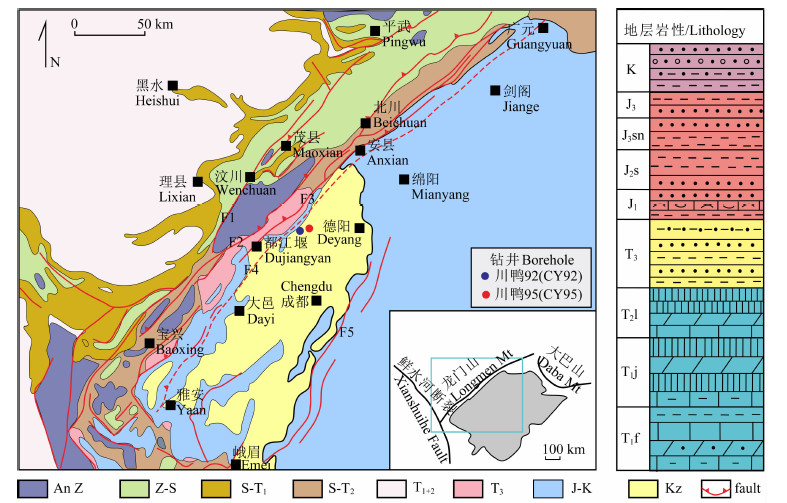 | 图 1 川西坳陷地质概况及地层柱状图(据赵建成等,2011;张永刚等,2007修改)Fig. 1 Geological sketch map and the stratigraphic column of the western Sichuan depression(modified from Zhao et al.,2011; Zhang et al.,2007) |
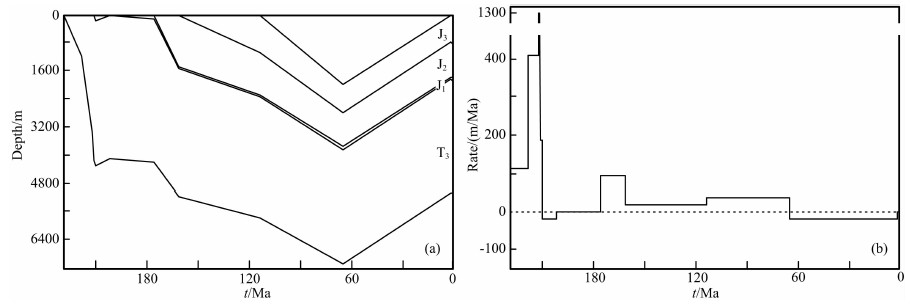 | 图 2 川西坳陷鸭子河地区川鸭92井地层埋藏史(a)和地质历史时期沉积剥蚀速率(b)Fig. 2 Strata buried history(a) and the rate of deposition and denudation of the borehole CY92 in the Yazihe area,western Sichuan depression |
鸭子河构造位于川西坳陷中南段,为龙门山推覆构造带中段前缘关口断裂下盘的半背斜构造,形成于喜马拉雅晚期,受控于关口和彭县断层,为一北东向断背斜(朱彤和梁恩宇,2001; 刘大成等,2002).根据生储盖发育情况,该区的含油气系统可以分为上三叠统-上侏罗统的上部陆相含油气系统和中三叠统及下伏地层构成的下部海相含油气系统(张永刚等,2007;赵建成等,2011).鸭子河构造的钻井,如川鸭92井、川鸭95井等,主要钻遇地层为上侏罗统至上三叠统的陆相层系(图 1),上三叠统煤系地层烃源岩包括煤、炭质页岩、灰-黑色泥岩和粉砂质泥岩,烃源岩较发育,以烃源岩为主的马鞍塘组、小塘子组、须三段和须五段的暗色泥岩厚度达几百米,须二段和须四段储层段内部也发育有机质丰度较高烃源岩的夹层(杨克明等,2003;陈冬霞等,2010).须家河组砂岩和侏罗系以陆内冲积扇、河、湖三角洲相沉积层构成该区陆相含油气系统的主要储集层.须三段、须五段、上侏罗统遂宁组泥、页岩作为上三叠统的区域盖层具有厚度大、突破压力高和分布稳定的特征,白垩系内的膏、盐层可作为侏罗系的直接盖层(汪泽成等,2002).
3 古温标数据及热史恢复 3.1 镜质体反射率热史恢复镜质体是一种煤素质,主要由芳香稠环化合物组成.随热成熟的增加,镜质体分子结构中的芳香环缩合度增大,形成更加密集的结构单元,从而使反射率增大(陈义才等,2007). Ro值的演化主要与有机质受热温度和时间有关,且以温度为主.随着镜质体反射率演化的热动力学机制研究的深入,利用Ro 恢复古地温的方法也由早期的图版法( Hood and et al.,1975; Cooper,1977)、TTI拟合法(Lopatin,1971; Waples,1980; Lerche et al.,1984)发展为干酪根热降解的化学动力学模型方法(Antia and David,1986; Braun and Burnham,1987; Armagnecl et al.,1989;Burnham et al.,1987,1989; Burnham and Sweeney,1989; Sweeney and Burnham,1990),其中,Sweeney和Burnham(1990)建立的EASY Ro%模型在目前的热史恢复中应用较广.
川鸭92井Ro数据主要集中在2000~5000 m的三叠系,Ro值主要在0.8%~2.0%之间,显示出随深度而增大的变化趋势.基于EASY Ro%模型,采用古地温梯度法(Duddy et al.,1991;胡圣标等,1998;邱楠生等,2004)恢复了川鸭92井的最高古地温(图 3).
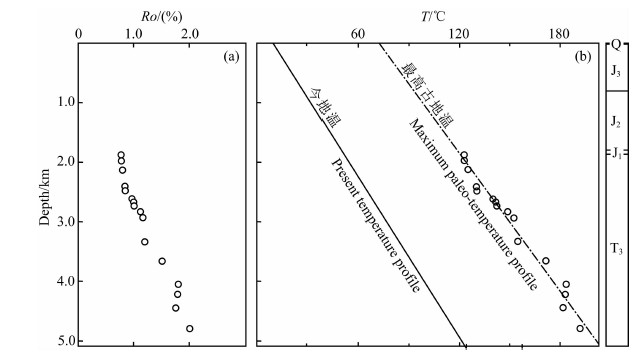 | 图 3 川鸭92井Ro数据(a)及古地温梯度法热史恢复结果(b)(反演中的岩石热物性参数采用了徐明等(2011)的研究成果)Fig. 3 Ro data(a) and thermal history reconstruction of CY92 using the paleo-temperature gradient method(b);the rock thermal properties data refer to Xu et al.(2011) |
该井的古地温梯度反演得到一条连续的最高古地温剖面,古地温梯度约26 ℃·km-1,热流约60 mW·m-2,上侏罗统与新生界之间不整合面的剥蚀量约1900 m. 该井最高古地温梯度大于现今约22 ℃·km-1的地温梯度,即地层达到最高古地温之后至现今,研究区的热演化总体上体现为冷却及抬升剥蚀的过程.
3.2 磷灰石裂变径迹热史模拟用于沉积盆地热史研究的低温热年代学方法主要包括磷灰石和锆石等矿物的裂变径迹和(U-Th)/He 分析.磷灰石裂变径迹(AFT)的退火温度(约60~120 ℃)与烃源岩生油的温度范围基本一致(Green et al.,1986;1989),又与地壳3~5 km深度范围内的多种地质过程相关(李天义等,2013),加之其独特的退火敏感性,逐步成为造山带抬升、沉积盆地沉降剥蚀历史和烃源岩热史模拟的重要手段,对于低温热年代学方法的原理和模拟方法已有较多的文献介 绍(Gleadow,1981;Gleadow et al.,1983;Gleadow and Fitzgerald,1987;Fitzgerald and Gleadow,1990;Fitzgerald et al.,1993; Armstrong et al.,1997;Armstrong,2005;Ketcham et al.,2007). 在应用磷灰石裂变径迹分析技术研究古地温时,常用两个方面的信息是裂变径迹的年龄和裂变径迹的长度(封闭径迹长度).
川鸭92井裂变径迹采样分布于2000~4500 m深度范围,CY92-1样品深度为2142 m,磷灰石裂变径迹中心年龄为42.3±3.0 Ma,径迹平均长度为11.76±0.26 μm,深度4474 m的CY92-3样品磷灰石裂变径迹年龄为4.3±0.6 Ma,没有测到长度数据(图 4).利用HeFty v1.7.4软件采用随机反演法(Corrigan,1991)模拟样品温度史,采用Ketcham等(2007)退火模型对CY92-1样品热历史模拟的结 果(图 5)显示:220—140 Ma为盆地沉降过程,145—80 Ma经历了一个热平静期;80 Ma以来开始抬升剥蚀,40—2.5 Ma之内盆地经历了一个热平静期,而后开始增温.晚期增温幅度在10 ℃左右,而该井新生界沉积仅有23.5 m,由沉积埋藏所造成的增温幅度基本可以忽略,因此,该次增温可能反应了地温梯度(以及热流)的增高,增高幅度约5 ℃·km-1.结合古地温梯度恢复结果,可推断约80 Ma以来研究区总体上体现为冷却及抬升剥蚀,但地温梯度的演化存在一定的波动,经历了降低再升高的过程,地温梯度在新近纪时期较小,可能低于20 ℃·km-1.根据模拟结果,CY92-1最高古地温在115~120 ℃左右,地层达到古地温的时期也是沉积埋藏达到最深时,参 照约26 ℃·km-1的地温梯度,此时样品埋深为4040 m,现今样品深度2142 m,剥蚀量约1900 m,与镜质体反射率恢复的结果基本一致.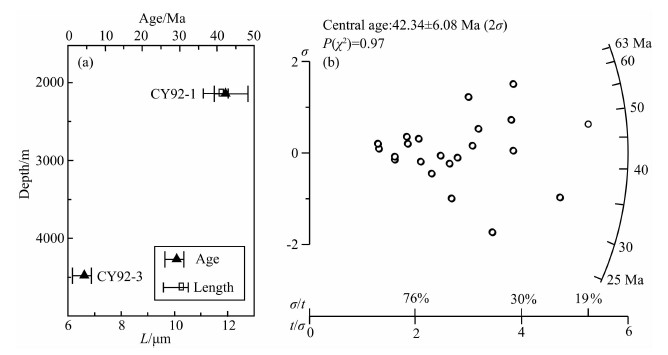 | 图 4 川鸭92井样品AFT年龄、长度数据(a)及CY-2样品AFT年龄辐射图(b)Fig. 4 AFT data of the samples of CY92(a) and the radar map of AFT ages of CY92-1(b) |
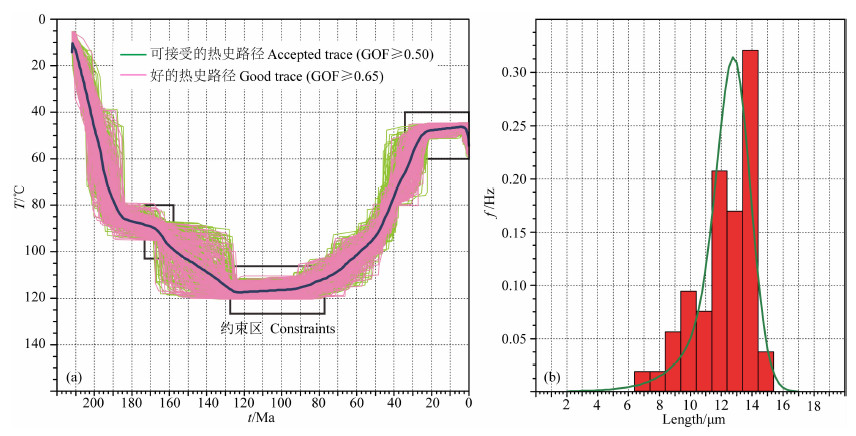 | 图 5 川鸭92井CY92-1磷灰石裂变径迹热史模拟结果(a)及径迹长度分布拟合(b);蒙特卡洛拟合法模拟10000条路径,拟合优度: GOF(age)=0.98;GOF(length)=0.95)Fig. 5 AFT thermal history modelingresult of CY92-1(a) and the fitting of AFT length distribution(b)(10000 paths have been modeled using Monte Carlo method,GOF(age)=0.98;GOF(length)=0.95) |
伊利石是沉积岩中主要黏土矿物之一,自生伊利石是沉积岩成岩演化阶段的重要产物,其晶体的结晶程度与地层岩石的成岩变质演化程度密切相关,随温度的增加而提高.因此,伊利石结晶度除了被用于成岩演化和极低级变质作用研究外,也可作 为最高地温计用于样品热史的恢复(王河锦等,2007; 朱莉和朱敏,2006; Bignall et al.,2001;Miller and Macdonald,2004;Aldega et al.,2003; Di,2003;Ji and Browne,2000).利用X射线衍射方法对伊利石结晶度进行研究,国际上普遍接受的测定伊利石结晶度的方法是采用Kübler指数来反映伊利石的结晶度,它用伊利石10(001)衍射峰的半高宽来表示(Kübler,1964;1967;1968;杨献忠,1993;朱光,1995;王河锦等,2000;游建昌等,2008),伊利石结晶度与Kübler指数负相关.
为了减小因样品制备、仪器条件、测试方法等差异所造成的测试结果差异(王河锦,1998),提高数据的可比性,测Kübler指数时可使用国际标样对数据进行校正.本文川鸭95井伊利石结晶度(图 6)测试为中国石油勘探开发研究院石油地质实验测试中心采用国际标样校正方法(游建昌等,2008)的测定结果.伊利石结晶度Kübler指数体现为随深度减小的线性关系(线性拟合:Y=-9168.76X+9988.64).
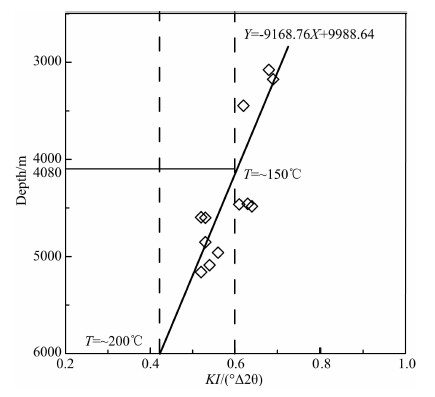 | 图 6 川鸭92井伊利石结晶度KI指数及古地温估算Fig. 6 KI data and the estimationpaleo-temperature of CY92 |
由成岩阶段经近变质阶段到浅变质阶段温度逐渐升高,伊利石结晶度增大,Kübler指数变小.一些研究者提出或归纳总结了伊利石结晶度与形成温度之间的关系以及基于伊利石结晶度的成岩-极低级变质作用的划分方案:晚期成岩带(高级成岩带),伊利石结晶度KI处于1.0~0.42(°Δ2θ)之间,温度上限200 ℃(KI=0.42(°Δ2θ)时,T=~200 ℃);埋藏变质阶段KI处于0.42~0.25(°Δ2θ)之间,温度为200~300 ℃(KI=0.25(°Δ2θ)时,T=~300 ℃);浅变质阶段(相当于低绿片岩相)KI<0.25(°Δ2θ),温度大于300 ℃(Kübler,1967;Arkai,2002;毕先梅和莫宣学,2004).伊利石结晶度在研究较低级的变 质作用方面的应用较为成熟,而对于成岩阶段(KI>0.42(°Δ2θ))的KI尚不能精确地建立与温度的对应关系.根据成岩-变质作用的划分(Arkai et al.,2002),参考前人发表的数据,KI=0.57(°Δ2θ),T =~141 ℃(125~163 ℃)(秦建中等,2009a);KI=0.56(°Δ2θ),T=156 ℃(136~177 ℃)(胡大千等,2012); KI=0.60~0.62(°Δ2θ),T=150 ℃(朱莉和朱敏,2006),可估算KI=0.60(°Δ2θ)时,最高古地 温约为150 ℃.由此推断川鸭95井深度在约4080 m时,KI=0.60(°Δ2θ),最高古地温约150 ℃;深度约6000 m时,KI=0.42(°Δ2θ)最高古地温约200 ℃,因J3-T3地层在抬升剥蚀前同时达到了最高古地温,故根据该两处深度上确定的古地温即可建立川鸭95井的最高地温剖面.
4 结果及讨论 4.1 热史恢复结果图 7为利用镜质体反射率(Ro)、磷灰石裂变径迹(AFT)恢复的川鸭92井和利用伊利石结晶度恢复的川鸭95井的最高古地温剖面.川鸭92井利用磷灰石裂变径迹恢复的最高古地温与镜质体反射率(Ro)的恢复结果较为一致,表明这两种应用较为成熟的古温标具有良好的可对比性.川鸭92井和川鸭95井的最高古地温剖面近于平行,表明两口钻井经历了相近的最高古地温梯度(约26 ℃·km-1)和古热流(约60 mW·m-2),这与其空间距离接近,处于相同地质背景,具有相似的构造、沉积演化历史的地质实际(刘大成等,2002)是吻合的.
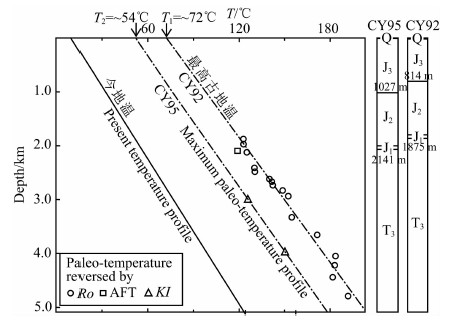 | 图 7 川鸭92井、川鸭95井古地温恢复结果对比Fig. 7 Comparison of the paleo-temperature reconstruction between CY91 and CY95 |
由于川鸭95井未有镜质体反射率(Ro)数据,根据其岩芯的岩石热解数据1)统计分析,2200~3000 m,Tmax=450~470 ℃,因川西地区上三叠统与侏罗系烃源岩有机质以Ⅲ型干酪根为主,参照Ⅲ型生油岩Tmax 与Ro关系图版,推测对应镜质体反射率 Ro=1.2%~1.4%;3300~4000 m,Tmax=480~500 ℃,推测Ro=1.6%~1.8%,均略小于川鸭92井对应深度的Ro值(图 3),而与伊利石结晶度所恢复的最高古地温有较好的对应关系.
1)地质矿产部西南石油地质局第十一普查勘探大队,四川省彭县鸭子河构造川鸭95井完井地质总结报告.1985.
两口井最高古地温剖面与现今地表交点处,T1约为 72 ℃,T2约为54 ℃,差值约18 ℃,以约26 ℃·km-1 的古地温梯度计算,剥蚀量差值约为690 m.结合磷灰石裂变径迹的模拟结果,可认为由晚白垩纪至今,研究区经历了冷却及抬升剥蚀的过程,地温梯度由 约26 ℃·km-1降低至约22 ℃·km-1,剥蚀量大约1.3~1.9 km.
4.2 存在问题本次研究中,各种古温标的热史恢复结果具有较好的一致性,但由于不同古温标之间的适用温度范围以及对温度的敏感区不同,在进行等效性对比时,仍存在一定的限制. AFT的封闭温度在120~130 ℃左右,对60~120 ℃的温度范围敏感,可以模拟样品的温度演化路径,Ro、伊利石结晶度则是最高古地温计,只能恢复样品经历的最高古地温.
利用伊利石结晶度Kübler指数估算埋藏变质或者浅变质时期的温度较为准确,而对于成岩阶段的古温度估算,虽有一些研究者建立起了利用KI进行温度估算的计算公式,如:


或探索了KI与Ro之间的对应关系(Guthrie et al.,1986;秦建中等,2009a,2009b),但其实际利用结果则不够理想.如:利用公式(1)计算的古地温与其他古温标确定的地温梯度相差较大(王强,2007);作为新生界断陷盆地,济阳坳陷的地层温度现今为最高,因此利用公式(2)计算的济阳—昌维凹陷的古地温梯度(约40 ℃·km-1)(周建国,2006;姜惠超等,2008)代表了现今地温梯度,该值较现今地温梯度(约35 ℃·km-1)(龚育龄等,2003)也偏高.秦建中等(2009a,2009b)建立的川东地区KI-Ro对应关系中,KI大于0.42(°Δ2θ)的数据较少,因而KI=0.57(°Δ2θ)的值偏离Ro-KI关系曲线.伊利石结晶度反映的古温度与镜质体反射率相似,不仅与经历的最高古温度相关,而且还与最高古温度所持续的时间有关(秦建中等,2009b),但它们随温度、时间演化的性质并不一致,因而某一确定的温度估算公式或等效关系,可能并不适用于更广泛的结晶度范围.如本文中伊利石结晶度KI数据随深度的线性拟合关系,推广至KI=0.25时,估算的最高古地温则与图 4中川鸭95井的最高古地温剖面不一致.相对低级-浅变质阶段伊利石结晶度的研究,成岩阶段伊利石结晶度演化过程的研究相对缺乏,而该阶段对自生伊利石的挑选以及测试精度、不同实验室之间数据对比等方面的要求更高,因此,伊利石结晶度作为成岩阶段有机质成熟度指标的应用,无论是测试标准还是热演化性质等,仍需要进一步探索.
5 结论1)川西坳陷镜质体反射率(Ro)、磷灰石裂变径迹(AFT)、伊利石结晶度(KI指数)的古地温恢复结果具有较高的一致性,可以作为研究区有效的古温标组合进行热史恢复.
2)热史恢复结果表明,晚白垩世至今,尽管第四纪可能存在地温梯度的增高,研究区总体仍表现为冷却与抬升剥蚀的过程:地温梯度由约26 ℃·km-1 降低至约22 ℃·km-1,剥蚀量约为1.3~1.9 km;145—80 Ma为热平静期,沉积缓慢或沉积间断,约 80 M以来开始抬升剥蚀,约40—2.5 Ma再次经历了 一个热平静期,第四纪以来地温梯度增高约5 ℃·km-1.
3)相对于镜质体反射率(Ro)和磷灰石裂变径迹(AFT)等模拟方法成熟古温标,伊利石结晶度用于沉积埋藏阶段的古地温恢复尚缺乏有效和统一的热演化模型,其作为有机质成熟度指标和沉积岩古温标的应用仍需进行定量化方面的探索.
致谢 样品采集得到中国石化西南油气分公司熊亮主任、何志国高工的帮助.
| [1] | Aldega L,Cello G,Corrado S,et al. 2003. Tectono-sedimentary evolution of the Southern Apennines (Italy): thermal constraints and modelling. Atti Ticinensi di Scienze Della Terra,9: 135-140. |
| [2] | Antia D D J. 1986. Kinetic method for modeling vitrinite reflectance. Geology,14(7): 606-608. |
| [3] | Arkai P,Sassi F P,Desmons J. 2002. Towards a unified nomenclature in metamorphic petrology: 4. Very low-to low-grade metamorphic rocks. A proposal on behalf of the IUGS subcommission on the systematics of metamorphic rocks. Web version of 31.10: 1-12. |
| [4] | Armagnel C,Bucci J,St Kendall G C,et al. 1989. Estimating the thickness of sediment removed at an unconformity using vitrinite reflectance data.//Naeser N D,McCulloh T H. Thermal History of Sedimentary Basins. New York: Springer-Verlag,Inc.,217-238. |
| [5] | Armstrong P A,Kamp P J J,Allis R G,et al. 1997. Thermal effects of intrusion below the Taranaki Basin (New Zealand): evidence from combined apatite fission track age and vitrinite reflectance data. Basin Research,9(2): 151-169. |
| [6] | Armstrong P A. 2005. Thermochronometers in Sedimentary Basins. Reviews in Mineralogy and Geochemistry,58(1): 499-525. |
| [7] | Bi X M,Mo X X. 2004. Transition from diagenesis to low-grade metamorphism and related minerals and energy resources. Earth Science Frontiers (in Chinese),11(1): 287-294. |
| [8] | Bignall G,Tsuchiya N,Browne P R L. 2001. Use of illite crystallinity as a temperature indicator in the Orakei Korako geothermal system,New Zealand. Transactions-Geothermal Resources Council,25: 339-344. |
| [9] | Braun R L,Burnham A K. 1987. Analysis of chemical reaction kinetics using a distribution of activation energies and simpler models. Energy & Fuels,1(2): 153-161. |
| [10] | Burnham A K,Braun R L,Gregg H R,et al. 1987. Comparison of methods for measuring kerogen pyrolysis rates and fitting kinetic parameters. Energy & Fuels,1(6): 452-458. |
| [11] | Burnham A K,Oh M S,Crawford R W,et al. 1989. Pyrolysis of Argonne premium coals: activation energy distribution and related chemistry. Energy & Fuels,3(1): 42-55. |
| [12] | Burnham A K,Sweeney J J. 1989. A chemical kinetic model of vitrinite maturation and reflectance. Geochimica et Cosmochimica Acta,53(10): 2649-2657. |
| [13] | Chen D X,Huang X H,Li L T,et al. 2010. Characteristics and history of hydrocarbon expulsion of the Upper Tertiary source rocks in the western Sichuan Depression. Natural Gas Industry (in Chinese),30(5): 41-45. |
| [14] | Chen Y. 2011. The formation of western Sichuan foreland basin and its significance in oil-gas exploration during late Triassic. Chengdu: Chengdu University of Technology. |
| [15] | Chen Y C,Shen Z M,Luo X P. 2007. Oil and Gas Organic Geochemistry (in Chinese). Beijing: Sciences Press. |
| [16] | Cooper B S. 1977. Estimation of the maximum temperature attained in sedimentary rocks.//Developments in Petroleum Geology. London: Applied Science Publications,127-146. |
| [17] | Corrigan J. 1991. Inversion of apatite fission track data for thermal history information. Journal of Geophysical Research,96(B6): 10347-10360. |
| [18] | Di L P. 2003. Use of clay mineralogy in reconstructing geological processes; thermal constraints from clay minerals. AttiTicinensi di Scienze della Terra,9: 55-67. |
| [19] | Duddy I R,Green P F,Laslett G M. 1988. Thermal annealing of fission tracks in apatite 3. Variable temperature behaviour. Chemical Geology,73(1): 25-38. |
| [20] | Fitzgerald P G,Gleadow A J W. 1990. New approaches in fission track geochronology as a tectonic tool: Examples from the transantarctic mountains. International Journal of Radiation Applications and Instrumentation. Part D. Nuclear Tracks and Radiation Measurements,17(3): 351-357. |
| [21] | Fitzgerald P G,Stump E,Redfield T F. 1993. Late Cenozoic uplift of Denali and its relation to relative plate motion and fault morphology. Science,259(5094): 497-499. |
| [22] | Gleadow A J W,Duddy I R,Lovering J F. 1983. Fission track analysis: a new tool for the evaluation of thermal histories and hydrocarbon potential. Australian Petroleum Exploration Association Journal,23: 93-102. |
| [23] | Gleadow A J W,Fitzgerald P G. 1987. Uplift history and structure of the Transantarctic Mountains: new evidence from fission track dating of basement apatites in the Dry Valleys area,southern Victoria Land. Earth and Planetary Science Letters,82(1-2): 1-14. |
| [24] | Gleadow A J W. 1981. Fission-track dating methods: What are the real alternatives. Nuclear Tracks,5(1-2): 3-14. |
| [25] | Gong Y L,Wang L S,Liu S W,et al. 2003. Distribution characteristics of geotemperature field in Jiyang depression,Shandong,north China. Chinese J. Geophys. (in Chinese),46(5): 652-658. |
| [26] | Green P F,Duddy I R,Gleadow A J W,et al. 1986. Thermal annealing of fission tracks in apatite: 1. A qualitative description. Chemical Geology,59: 237-253. |
| [27] | Green P F,Duddy I R,Laslett G M,et al. 1989. Thermal annealing of fission tracks in apatite 4. Quantitative modelling techniques and extension to geological timescales. Chemical Geology,79(2): 155-182. |
| [28] | Guo Z W,Deng K L,Han Y H,et al. 1996. Formation and Evolution of the Sichuan Basin (in Chinese). Beijing: Geological Publishing House. |
| [29] | Guthrie G M,Houseknecht D W,Johns W D. 1986. Relationships among vitrinite reflectance,illite crystallinity,and organic geochemistry in Carboniferous strata,Ouachita mountains,Oklahoma and Arkansas. AAPG Bulletin,70(1): 26-33. |
| [30] | Hood D,Gutjahr C C M,Heacock R L. 1975. Organic metamorphism and the generation of petroleum. AAPG Bulletin,59(6): 986-996. |
| [31] | Hu D Q,Han C Y,Ma R,et al. 2012. The very low grade metamorphism in the Upper Paleozoic in Xinlingol area of Inner Mongolia,NE China: Evidence from studies of illite and vitrinite reflectance. Acta Petrologica Sinica (in Chinese),28(9): 3042-3050. |
| [32] | Hu S B,Zhang R Y,Zhou L C. 1998. Reconstruction of geothermal history in hydrocarbon basins. Petroleum Explorationist (in Chinese),3(4): 52-54. |
| [33] | Hu S B,He L J,Zhu C Q,et al. 2008. Method system of thermal reconstruction for marine basins. Oil and Gas Geology (in Chinese),29(5): 607-613. |
| [34] | Ji J F,Browne P R L. 2000. Relationship between illite crystallinity and temperature in active geothermal systems of New Zealand. Clays and Clay Minerals,48(1): 139-144. |
| [35] | Jiang H C,Xiao Y J,Zhou L. 2008. Analysis of Cenozoic subsurface temperatures of the Jiyang depression. Geology in China (in Chinese),35(2): 273-278. |
| [36] | Ketcham R A,Carter A,Donelick R A,et al. 2007. Improved modeling of fission-track annealing in apatite. Am. Mineral.,92(5-6): 799-810. |
| [37] | Kübler B. 1964. Les argiles,indicateurs de métamorphisme. Rev. Inst. Franc. Petrole Ann. Combüst.,19: 1093-1112. |
| [38] | Kübler B. 1967. La cristallinite de I'illite et les zones tout a fait superieures du métamorphisme. Etages tectoniques. Colloque de Neuchatel,105-121. |
| [39] | Kübler B. 1968. Évaluationqunaittative du métamorphismepar la cristallinitE de I'illité. Bulletin du Centre de Recherehes de pua-SNAP,2: 385-397. |
| [40] | Lerche I,Yarzab R F,St C Kendall C G. 1984. Determination of paleoheat flux from vitrinite reflectance data. AAPG Bulletin,68(11): 1704-1717. |
| [41] | Li J W,Qiu N S,Mei Q H,et al. 2011. Study on measuring the highest rock paleotemperature with thermo-acoustic emission. Chinese J. Geophys. (in Chinese),54(11): 2898-2905. |
| [42] | Li T Y,Zhou Y,Fang S,et al. 2013. A new method for apatite fission track dating—the Laser-ICPMS method. Oil & Gas Geology (in Chinese),34(4): 550-557. |
| [43] | Li Z W,Liu S G,Chen H D,et al. 2011. Structural superimposition and conjunction and its effects on hydrocarbon accumulation in the Western Sichuan Depression. Petroleum Exploration and Development (in Chinese),38(5): 538-551. |
| [44] | Liu D C,Li S S,Zhou Z J,et al. 2002. Oil and gas exploration target selection and evaluation of the Xujiahe formation in the Yazi River structure. Natural Gas Exploration and Development (in Chinese),25(1): 38-45. |
| [45] | Liu D H,Xiao X M,Tian H,et al. 2013. Sample maturation calculated using Raman spectroscopic parameters for solid organics: Methodology and geological applications. Chinese Science Bulletin,58(11): 1285-1298. |
| [46] | Liu H P,Li J M,Li X Q,et al. 2006. Evolution of cratonic basins and carbonate-evaporite sedimentary sequence hydrocarbon systems in China. Geoscience (in Chinese),20(1): 1-18. |
| [47] | Liu J H,Yang S C,Zhang S Q,et al. 2010. A study on the characters of the accommodation change and hydrocarbon in Upper Xujiahe formation in the Western Sichuan Basin. Geological Review (in Chinese),56(2): 275-282. |
| [48] | Liu S G,Yang R J,Wu X C,et al. 2009. The Late Triassic transition from marine carbonate rock to clastics in the western Sichuan Basin. Oil & Gas Geology (in Chinese),30(5): 556-565. |
| [49] | Liu S G,Deng B,Li Z W,et al. 2011. The texture of sedimentary basin-orogenic belt system and its influence on oil-gas distribution: A case study from Sichuan basin. Acta Petrologica Sinica (in Chinese),27(3): 621-635. |
| [50] | Lopatin N V. 1971. Temperature and geological time as factors of carbonification. Akademy Nauk SSSR Izvestias Serie Geologia,3: 95-106. |
| [51] | Ma C,Browne P R L,Harvey C C. 1992. Crystallinity of subsurface clay minerals in the Te Mihi Sector of the Wairakei geothermal system,New Zealand.//Proc. 14th New Zealand Geothermal Workshop,267-272. |
| [52] | Ma Y S,Chen D H,Wang G L,et al. 2009. Sequence Stratigraphy and Paleogeography in Southern China (in Chinese). Beijing: Science Press. |
| [53] | Miller S,Macdonald D I M. 2004. Metamorphic and thermal history of a fore-arc basin: the Fossil Bluff Group,Alexander Island,Antarctica. Journal of Petrology,45(7): 1453-1465. |
| [54] | Morgan P. 1984. The thermal structure and thermal evolution of the continental lithosphere. Phys. Chem. Earth,15: 107-193. |
| [55] | Qin J Z,Li Z M,Teng G E. 2009a. A study on paleo-geothermometer of high mature marine sequences in South China. Oil & Gas Geology (in Chinese),30(5): 608-618. |
| [56] | Qin J Z,Teng G E,Yang Q,et al. 2009b. Research on maturity indicators of high-maturity marine strata in the eastern Sichuan Basin. Acta Petrolei Sinica (in Chinese),30(2): 208-213. |
| [57] | Qiu N S,Hu S B,He L J. 2004. Theory and Application of the Sedimentary Basins Thermal Regime Research (in Chinese). Beijing: Petroleum Industry Press. |
| [58] | Qiu N S,Li H L,Jin Z J. 2005. Study of the thermal history reconstruction for Lower Paleozoic carbonate succession. Earth Science Frontiers (in Chinese),12(4): 561-567. |
| [59] | Sweeney J J,Burnham A K. 1990. Evaluation of a simple model of vitrinite reflectance based on chemical kinetics. AAPG Bulletin,74(10): 1559-1570. |
| [60] | Tao X F. 1999. Evolution of nappe tectonic and foreland basin in the southern section of Longmen mountains. Journal of Chengdu University of Technology (in Chinese),26(1): 73-77. |
| [61] | Tian Y T,Kohn B P,Gleadow A J W,et al. 2013. Constructing the Longmen Shan eastern Tibetan Plateau margin: Insights from low-temperature thermochronology. Tectonics,32(3): 576-592. |
| [62] | Tissot B P,Welte D H. 1984. Petroleum Formation and Occurrence. New York: Springer Verlag. |
| [63] | Tissot B P,Pelet R,Ungerer P. 1987. Thermal history of sedimentary basins,maturation indices,and kinetics of oil and gas generation. AAPG Bulletin,71(12): 1445-1466. |
| [64] | Wang H J,Zhu M X,Xu Q S,et al. 2000. Relationship between slit system and the Kübler index of illite crystal unity and discussion on relevant problems. Geological Review (in Chinese),46(6): 588-593. |
| [65] | Waples D W. 1980. Time and temperature in petroleum formation: Application of Lopatin's method to petroleum exploration. AAPG Bulletin,64(6): 916-926. |
| [66] | Wang H J,Tao X F,Rahn M. 2007. Some aspects of illite crystallinity and its applications in low temperature metamorphism. Earth Science Frontiers (in Chinese),14(1): 151-156. |
| [67] | Wang H J. 1998. On the error calculation of the Kübler index of illite crystallinity. Geological Review (in Chinese),44(3): 328-335. |
| [68] | Wang J. 1996. Geothermics in China. Beijing: Seismological Press. |
| [69] | Wang Q. 2007. Clay minerals research and application: as geothermometers (in Chinese). Qingdao: China University of Petroleum. |
| [70] | Wang T Z. 1997. Significance of Longmenshan thrust in evolution and oil-gas exploration of western Sichuan basin. Geoscience (in Chinese),11(4): 496-500. |
| [71] | Wang Z C,Zhao W Z,Zhang L,et al. 2002. Structural Sequence and Natural Gas Exploration of the Sichuan Basin (in Chinese). Beijing: Geological Publishing House. |
| [72] | Xu C H,Zhu G,Liu G S,et al. 2005. Application of Crystallinity of Illite to Recover Denudation Quantity: An example of cretaceous denudation quantity recovery of well Ancan 1 in Hefei basin,Anhui province. Geological Science and Technology Information (in Chinese),24(1): 41-44. |
| [73] | Xu M,Zhu C Q,Tian Y T,et al. 2011. Borehole temperature logging and characteristics of subsurface temperature in the Sichuan Basin. Chinese J. Geophys. (in Chinese),54(4): 1052-1060. |
| [74] | Yang K M,Zhu T,He L. 2003. Structural characteristics and exploration potential of the thrust block in Longmenshan. Petroleum Geology & Experiment (in Chinese),25(6): 685-700. |
| [75] | Yang X Z. 1993. Illite crystallinity and its geological significances. Acta Sedimentologica Sinaca (in Chinese),11(4): 92-98. |
| [76] | You J C,Bi X M,Hou C M. 2008. Calibration of illite crystallinity measurements by using international standards and its significance. Geosciences (in Chinese),22(1): 53-59. |
| [77] | Zhang Y G,Ma Z J,Yang K M,et al. 2007. The forecast of natural oil & gas potential in marine strata,western Sichuan basin,southwest China. Acta Geologica Sinica (in Chinese),81(8): 1041-1047. |
| [78] | Zhao J C,Liu S G,Sun W,et al. 2011. Analysis on petroleum preservation condition in the coupling area between Longmen Mountain and Sichuan Basin. Lithologic Reservoirs (in Chinese),23(1): 79-85,89. |
| [79] | Zhou J G. 2006. Analysis of Early-Cenozoic Prototype Basin and its structural thermal evolution characteristic study of Jiyang-Changwei depression (in Chinese). Beijing: Graduate University of China Academy of Sciences. |
| [80] | Zhu G. 1995. Grading the extreme-low metamorphic clastic sedimentary rocks by the crystallinity of the illite. Petroleum Exploration and Development (in Chinese),22(1): 33-34. |
| [81] | Zhu L,Zhu M. 2006. Thermal evolution stages for mesozoic strata in the Hefei basin: contstraints from illite crystallinity. Geology of Anhui (in Chinese),16(3): 169-172,176. |
| [82] | Zhu T,Liang E Y. 2001. Discussion on oil and gas exploration of Xujiahe group in Yazi River structure of the middle Longmenshan in western Sichuan. Journal of Chengdu University of Technology (in Chinese),28(1): 59-63. |
| [83] | 毕先梅,莫宣学. 2004. 成岩-极低级变质-低级变质作用及有关矿产. 地学前缘,11(1): 287-294. |
| [84] | 陈冬霞,黄小惠,李林涛等. 2010. 川西坳陷上三叠统烃源岩排烃特征与排烃史. 天然气工业,30(5): 41-45. |
| [85] | 陈杨. 2011. 川西晚三叠世前陆盆地的形成演化过程及油气勘探意义\[博士论文\].成都: 成都理工大学. |
| [86] | 陈义才,沈忠民,罗小平. 2007. 石油与天然气有机地球化学. 北京: 科学出版社. |
| [87] | 龚育龄,王良书,刘绍文等. 2003. 济阳坳陷地温场分布特征. 地球物理学报,46(5): 652-658. |
| [88] | 郭正吾,邓康龄,韩永辉等. 1996. 四川盆地形成与演化. 北京: 地质出版社. |
| [89] | 胡大千,韩春元,马瑞等. 2012. 内蒙古锡林郭勒地区上古生界极低级变质作用: 伊利石和镜质体反射率的证据. 岩石学报,28(9): 3042-3050. |
| [90] | 胡圣标,张容燕,周礼成. 1998. 油气盆地地热史恢复方法. 勘探家,3(4): 52-54. |
| [91] | 胡圣标,何丽娟,朱传庆等. 2008. 海相盆地热史恢复方法体系. 石油与天然气地质,29(5): 607-613. |
| [92] | 姜惠超,肖永军,周丽. 2008. 济阳坳陷新生代古地温分析. 中国地质,35(2): 273-278. |
| [93] | 李佳蔚,邱楠生,梅庆华等. 2011. 利用热声发射技术测量岩石最高古温度的探索. 地球物理学报,54(11): 2898-2905. |
| [94] | 李天义,周雁,方石等. 2013. 磷灰石裂变径迹年龄测试分析新方法——激光剥蚀-ICPMS法. 石油与天然气地质,34(4): 550-557. |
| [95] | 李智武,刘树根,陈洪德等. 2011. 川西坳陷复合-联合构造及其对油气的控制. 石油勘探与开发,38(5): 538-551. |
| [96] | 刘大成,李书舜,周志军等. 2002. 鸭子河构造深层须家河组油气勘探目标选择与评价. 天然气勘探与开发,25(1): 38-45. |
| [97] | 刘和甫,李景明,李晓清等. 2006. 中国克拉通盆地演化与碳酸盐岩-蒸发岩层序油气系统. 现代地质,20(1): 1-18. |
| [98] | 刘金华,杨少春,张世奇等. 2010. 川西地区上三叠统须家河组前陆盆地可容空间变化特征与油气成藏研究. 地质论评,56(2): 275-282. |
| [99] | 刘树根,杨荣军,吴熙纯等. 2009. 四川盆地西部晚三叠世海相碳酸盐岩——碎屑岩的转换过程. 石油与天然气地质,30(5): 556-565. |
| [100] | 刘树根,邓宾,李智武等. 2011. 盆山结构与油气分布——以四川盆地为例. 岩石学报,27(3): 621-635. |
| [101] | 马永生,陈洪德,王国力等. 2009. 中国南方层序地层与古地理. 北京: 科学出版社. |
| [102] | 秦建中,李志明,腾格尔. 2009a. 中国南方高演化海相层系的古温标. 石油与天然气地质,30(5): 608-618. |
| [103] | 秦建中,腾格尔,杨琦等. 2009b. 川东地区海相高演化层系的成熟度指标研究. 石油学报,30(2): 208-213. |
| [104] | 邱楠生,胡圣标,何丽娟. 2004. 沉积盆地热体制研究的理论与应用. 北京: 石油工业出版社. |
| [105] | 邱楠生,李慧莉,金之钧. 2005. 沉积盆地下古生界碳酸盐岩地区热历史恢复方法探索. 地学前缘,12(4): 561-567. |
| [106] | 陶晓风. 1999. 龙门山南段推覆构造与前陆盆地演化. 成都理工学院学报,26(1): 73-77. |
| [107] | 王河锦,朱明新,徐庆生等. 2000. 狭缝系统与伊利石结晶度Kübler指数的测定及相关问题讨论. 地质论评,46(6): 588-593. |
| [108] | 王河锦,陶晓风,Rahn M. 2007. 伊利石结晶度及其在低温变质研究中若干问题的讨论. 地学前缘,14(1): 151-156. |
| [109] | 王河锦. 1998. 关于伊利石结晶度Kübler指数的误差计算. 地质论评,44(3): 328-335. |
| [110] | 王强. 2007. 粘土矿物地温计研究与应用\[硕士论文\]. 青岛: 中国石油大学. |
| [111] | 王天泽. 1997. 龙门山逆冲作用在川西盆地演化及油气勘探中的意义. 现代地质,11(4): 496-500. |
| [112] | 汪泽成,赵文智,张林等. 2002. 四川盆地构造层序与天然气勘探. 北京: 地质出版社. |
| [113] | 徐春华,朱光,刘国生等. 2005. 伊利石结晶度在恢复地层剥蚀量中的应用——以合肥盆地安参1井白垩系剥蚀量的恢复为例. 地质科技情报,24(1): 41-44. |
| [114] | 徐明,朱传庆,田云涛,等. 2011. 四川盆地钻孔温度测量及现今地热特征. 地球物理学报,54(4): 1052-1060. |
| [115] | 杨克明,朱彤,何鲤. 2003. 龙门山逆冲推覆构造带构造特征及勘探潜力分析. 石油实验地质,25(6): 685-700. |
| [116] | 杨献忠. 1993. 伊利石的结晶度及其地质意义综述. 沉积学报,11(4): 92-98. |
| [117] | 游建昌,毕先梅,侯纯敏. 2008. 应用国际标样对伊利石结晶度测定值的校正及其意义. 现代地质,22(1): 53-59. |
| [118] | 张永刚,马宗晋,杨克明等. 2007. 川西坳陷中段海相层系油气勘探潜力分析. 地质学报,81(8): 1041-1047. |
| [119] | 赵建成,刘树根,孙玮等. 2011. 龙门山与四川盆地结合部的油气保存条件分析. 岩性油气藏,23(1): 79-85,89. |
| [120] | 周建国. 2006. 济阳—昌潍坳陷早新生代原型盆地分析及构造热演化特征研究. 北京: 中国科学院研究生院. |
| [121] | 朱光. 1995. 用伊利石结晶度确定碎屑沉积岩甚低级变质等级. 石油勘探与开发,22(1): 33-34. |
| [122] | 朱莉,朱敏. 2006. 合肥盆地中生界地层的热演化程度——伊利石结晶度的指示. 安徽地质,16(3): 169-172,176. |
| [123] | 朱彤,梁恩宇. 2001. 龙门山中段前缘鸭子河构造深层须家河组油气勘探. 成都理工学院学报,28(1): 59-63. |
 2015, Vol. 58
2015, Vol. 58

